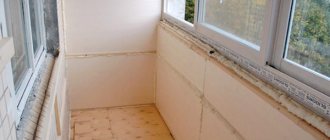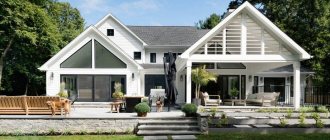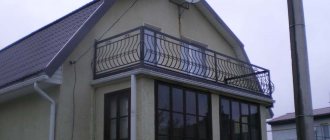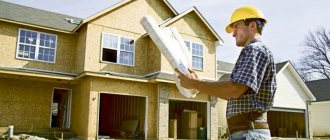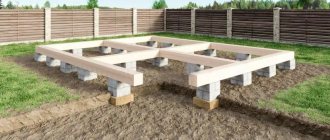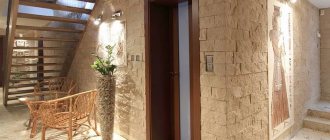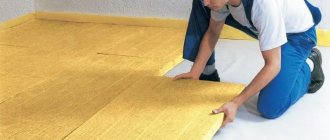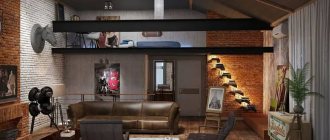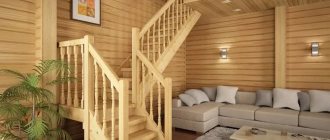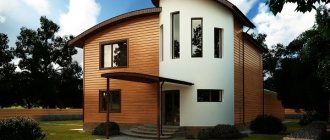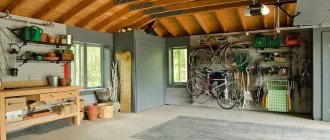Any owner of a plot of land wants to build a house from high-quality, environmentally friendly materials, and this is not surprising. A home is a place where a person takes a break from a busy day, spends time with his family, and receives guests. We spend most of our free time within the walls of our home, and they should create a good indoor microclimate.
All materials for the construction of a residential building are divided into three groups according to environmental friendliness:
- harmful;
- moderately harmful;
- harmless.
There is not a single material, even natural, that can be said to be useful, but there are environmental materials for construction.
Ecological Material Designation Table
It is no secret that in a modern city we receive a lot of harmful substances from the atmosphere, various radiations in the home from household appliances, so it is advisable to build a country house from environmentally friendly material.
Absolutely and conditionally environmentally friendly materials
Absolutely environmentally friendly materials are considered natural, those from which our ancestors built their houses for centuries: wood, stone (in extreme cases, brick), straw, natural drying oil, slate, clay, and so on.
Conditionally environmentally friendly building materials include more modern, but also seemingly safe:
- brick;
- roofing tiles;
- foam concrete blocks;
- materials made from aluminum and silicon.
What other symbols should you look for on the label?
Most manufacturers of modern building materials strive to achieve the greatest environmental friendliness of their products, and every self-respecting company labels its products. The environmental friendliness of building materials can be determined by the following markings:
- E1 – completely safe building materials for children’s rooms and any other room.
- E2 – suitable for kitchens, bathrooms, corridors.
- E3 - not suitable for residential premises, used for finishing technical premises.
How safe is a brick?
Let's leave extreme cases like thatched houses with aspen shingles roofing and consider more traditional materials for building a country house. One of the first on the safe list is brick. It seems like this is material from which you can’t expect any tricks! If you look at brick from the point of view of environmental safety, it turns out that it has simply fantastic characteristics.
- Ordinary brick is made only from natural ingredients: clay, sand and water.
- The brick is fired at temperatures above 950 degrees Celsius. It is fireproof, does not burn and does not support combustion. In accordance with GOST 30244, it belongs to non-combustible materials.
- The resources of clay and sand are practically unlimited; they can be used without harming nature. Ceramic bricks are durable and can last more than 100 years.
- And after that, the brick can be easily disposed of without harming the environment.
The only danger of brick as a building material is its potential radioactivity. The developer is not always able to control where the sand and clay for brick production are taken from.
A member of our portal with the nickname MariusY was building a dacha on the border of the Moscow and Tula regions. Before starting construction, he checked all construction materials with a household dosimeter. Everything was normal, the radiation level did not exceed the natural background. Then Marius relaxed and laid out a barbecue complex in the gazebo from untested stove bricks on fireclay clay with sand; the firebox section for the cauldron and barbecue was lined with fireclay bricks.
Upon completion of construction, it turned out that the level of radiation in the barbecue section was several times higher than the natural background of the area where the dacha is located. A check of the remaining materials showed that the highest radiation level was in the stack of 10 remaining fireclay bricks, but the red brick was also too high.
MariusYFORUMHOUSE Member
A step away from the barbecue complex, the radiation corresponds to the natural background.
Forum members called this situation alarming: “What if the whole house is made of such bricks?” and recommended that the owner of the barbecue complex take a selection of samples from different batches to a certified laboratory. Identified violations will be the basis for claims against the seller who sold the product that does not comply with radiation standards.
If a brick is “phonic”, this does not mean that it was made from clay mined at the site of the nuclear power plant accident. The very location where materials are mined can affect the levels of naturally occurring radionuclides.
The risk of buying radioactive bricks is generally not great: all enterprises that make bricks, tiles, etc., necessarily conduct radiological studies of products , the results of which are confirmed by quality certificates. You just need to remember that safety is the main value of a person who builds his own house and try to be like our participant with the nickname cnt200.
cnt200FORUMHOUSE Member
About ten years ago I came across phony cement (39), and since then I have always checked building materials. Due to the specifics of my work, I repeatedly encountered “smart guys” who believed that fairy tales about radiation were spread by enemies and Chubais in order to capture us.
Harmless insulation materials
Ecowool
One of the most environmentally friendly types of insulation. It does not emit harmful, volatile substances into the air and has a high thermal insulation ability. It fits tightly to the base, leaving no gaps or bridges of cold, which cannot be said about a slab insulation product.
The process of insulating a house with ecowool
The material is not flammable - this is confirmed by many tests carried out by the manufacturers. In addition, due to its insulating ability, it prevents the rapid spread of fire in the event of a fire. The material contains a natural boron antiseptic, which does not allow fungal infections to form, and insects and rodents do not live in it.
Ecowool for building insulation
Foam glass
Insulation, which is widely used for thermal insulation of buildings and structures, with good characteristics confirmed by a quality certificate:
- fire resistance;
- moisture resistance;
- strength;
- non-flammability;
- durability;
- strength;
- resistance to chemical influences.
The process of laying foam glass The only limitation for the use of this material is its cost.
Wave
Natural insulator made from flax production waste. It is produced in the form of a mat in which thin flax fibers are bonded using polymers, which are unsuitable for further processing.
The product is non-flammable and is used for both external and internal insulation. It has proven itself well as a sound insulator.
During production, the material is treated with antiseptic drugs, so it is not susceptible to rotting and infection by fungi.
The process of insulating the attic with special mats
The process of attaching mineral wool to walls You can often find mats with an aluminum film on one side, which allows them to reflect heat rays. Such mats, installed with film insulation to the room, allow you to create the effect of a thermos, which helps to save thermal energy.
What are the dangers of wood
Wood is one of the most environmentally friendly materials, the main material for the construction of eco-houses. The tree is good no matter how you look at it. Many people note: in log wooden houses it is always easy to breathe, they have an optimal microclimate and there is no dampness. It is from wood that frames for thatched houses are made.
But here it is important that the wood is harvested in winter and well dried. And it’s always worth thinking about what protective compounds it has been treated with. Wooden structures are treated to protect them from mold, fungi, ultraviolet radiation, humidity, bark beetles, and so on. Usually two compounds are applied: against insects and against environmental influences.
A number of these protective agents are truly dangerous for humans. Many chemicals are considered harmless, but it is no longer inappropriate to talk about the absolute environmental friendliness of wood after their use. In addition, any paint and varnish product can become dangerous if it is not stored correctly.
Of course, you can refuse synthetic protective compounds: thank God, in Rus' houses were cut down long before they appeared. But here the question fully arises of how ready people are for this.
FortunaForumHouse Member
We must not forget the secrets of the old masters. But I wonder what percentage of homeowners would agree to coat the inside of their new, newly built house with clay? How many people will refuse to impregnate wood with Finnish protective compounds and prefer a saline solution?
Recycled glass
Bet you didn't think that wine bottles could end up recycled in your kitchen? Glass does not decompose, but if you recycle broken glass items, they can be given a new life. There the glass is broken into small pieces and bonded to the concrete. Window panes can make clear glass, while broken plates or bottles can make glass of any color.
Natural drying oil - who has seen it?
Adherents of ecological housing try to treat wooden log houses with natural compounds, for example, natural drying oil. The photograph shows the result of such processing.
The man specially ordered linseed oil and wax from Altai, heated it, mixed it and processed it.
This method also has several pitfalls: it is incredibly expensive; not everyone can withstand such a colorful ornament; It is very difficult to get real natural drying oil and real linseed oil. And most importantly, this coating is not intended for outdoor use.
TulupFORUMHOUSE Member
Over the course of a year, the coating with drying oil practically disappears, as if it evaporates and the wood remains almost dry. To give it a presentable appearance, it needs to be coated again. I believe that it has the right to life as an inexpensive treatment of unpresentable structures.
Drying oil is a vegetable oil, hemp, linseed or nut, partially polymerized by heating or other means. FORUMHOUSE describes cases where workers offered to cheaply and environmentally treat a log house with hot sunflower oil. But you cannot replace linseed oil with sunflower oil: it does not dry out completely, never forms a film, but it darkens and turns bitter.
MumiForumHouse Member
No workers will get flaxseed; it is not widely sold. They will heat you up oxol with the addition of technical rapeseed oil and hello.
Another point: our participant with the nickname SDP claims that natural drying oil is very difficult to get. Even artists have a big problem with this: it’s just that now Shrovetide flax varieties are grown in rather modest quantities in the vast expanses of the former USSR.
SDPU member FORUMHOUSE
For artists, getting natural, even sunflower-based, drying oil is a big problem. Varnishes are made from linseed and hemp oils, which I use to treat luxury leather and luxury furniture, the price is astronomical!
Therefore, when finishing wood with something natural and environmentally friendly, it is good to make sure that it is not a fake.
Selecting windows
When replacing window structures in your home, you should pay attention to wooden windows , which are characterized by an affordable price and a high level of environmental friendliness.
However, if you need a high level of heat and sound insulation, then preference should be given to structures based on aluminum profiles , which, although they are much cheaper, have the best durability and practicality.
PVC profile is a completely artificial product, but thanks to modern processing methods, it is completely safe and suitable for all areas of the house.
Should we blindly trust foam concrete?
Foam concrete in Europe is also called eco-concrete. In the list of environmental materials it comes right after wood. Environmentalists love him.
There is an article on FORUMHOUSE in which the composition of foam blocks is literally broken down into molecules. It seems to be completely safe.
Foam for foam concrete is made from natural ingredients, aluminum is included in the blocks in the form of safe compounds, the likelihood that “contaminated” cement and sand, sources of radioactive radiation, will get into its composition is close to zero. The composition of cellular concrete includes lime and safe quartz sand, and not granite crushed stone - you don’t have to worry.
But you still can’t relax completely when buying foam blocks. Foam concrete may contain ash and slag contaminated with heavy metals and containing a high concentration of radioactive elements.
It all depends on the integrity of the block manufacturer.
MISHA_KFORUMHOUSE Member
Marble is also phonic, but the marble is mostly imported; at all borders there are dosimeters for trucks - it’s easier here. And local production - whatever you want, as long as it’s cheaper.
As we see, this super eco-friendly material can also be unsafe. You still need to read real reviews, recommendations, and look for reputable sellers and manufacturers.
List of documents that need to be studied before purchasing foam blocks:
- environmental certificates;
- GOST certificates of conformity;
- sanitary and hygienic conclusions;
- documents confirming the absence of radionuclide emissions.
Concrete
All over the world, concrete is used as a durable, inexpensive material that can easily withstand the onslaught of time and the elements. Concrete has now come in a variety of new colors and shapes, turning countertops and flooring into works of art.
The environmental friendliness of the material is a controversial topic. On the one hand, concrete production requires little energy, and therefore reduces electricity consumption. It is also virtually waste-free, as it is made to order for each project. There are no toxic substances in concrete that will evaporate at normal temperatures. In addition, concrete is made using ash, a byproduct of coal products that would otherwise be sent to landfills.
On the other hand, concrete production produces large amounts of carbon dioxide, accounting for about 7% of global CO2 emissions. Some companies have already started using a different type of cement, which has helped to sharply reduce emissions, but such concrete is several times more expensive than usual.
The industry as a whole is changing, production will become more environmentally friendly in the future. Therefore, concrete can become the material of the future.
